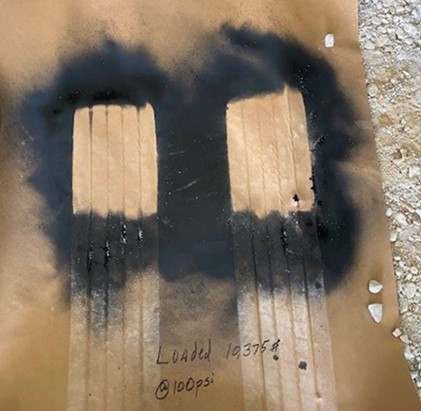Tyre contact area in unpaved road design – does it matter?
by Andrew Lees, on juli 13, 2023
.png)
Figure 1 - Tyre contact area (image courtesy of Tyre Rack.com)
When designing for unpaved roads, the two primary considerations are subgrade strength and vehicle loading. Subgrade strength has been addressed extensively in previous blogs, and the focus here is to explain why tyre contact does matter. Vehicle load is transferred to the surface via the tyres and the vertical stress being applied to the surface is of course dependent upon the tyre contact area. We would expect that the greater the contact area, then the lower the applied stress. We have seen off-road ‘swamp buggies’ with oversize, low pressure tyres that exploit this to avoid getting bogged down in soft ground.
.jpg)
Figure 2 - Swamp buggy, over size low pressure tyres (image courtesy Babcock Ranch)
Clearly, tyre contact area will have an influence on the performance of unpaved roads.
\What is tyre contact area?
When a loaded wheel is in contact with a hard road surface such as concrete, the tyre deforms. The area over which the tyre makes contact with the surface is the tyre contact area. The size of the contact area depends upon the tyre deformation and that will depend upon the tyre inflation pressure. Higher pressure would result in a reduced tyre contact area.
The shape of the tyre contact area is often assumed to be circular in simplified design methods, however this is incorrect as we will see later.
Tyre contact area for unpaved roads
.jpg)
Figure 3 - Surface deformation increases contact area (image courtesy of Petri Varsin)
The materials used to surface unpaved roads will typically have a lower bearing capacity than the tyre inflation pressure of trucks. Tyre inflation pressures for commercial vehicles have increased over the years and can easily exceed 700kPa, which is about twice the yield stress of an unbound aggregate. The road surface will therefore deform under the tyre load form a truck. The tyre ‘sinks in’ to the aggregate, increasing the tyre contact area until the contact pressure is equal to bearing capacity of the aggregate.
Because if this effect, the actual vertical stress across the true tyre contact area is lower than for the condition where zero surface deformation has been assumed.
How does tyre contact area influence unpaved road design?
.jpg)
Figure 4 - Tyre contact area is an important input for unpaved road design (image courtesy Brad Lokyer)
Some empirical design methods use only axle loads and ignore tyre pressure: more analytical methods, such as Giroud and Han, do consider tyre contact area and pressure. These methods have all assumed that the contact area is circular, even for dual wheels, and that vertical stress equal to the tyre inflation pressure, is uniformly distributed across the contact area. This approach works well for paved roads, but research suggests that for unpaved roads the assumption that vertical stress equals the tyre pressure can overestimate contact stress and underestimate the contact area and depth of influence. This could result in an underestimate of subgrade stress and an inadequate design.
Taking a fresh look at tyre contact area
.jpg)
Figure 5 - Tyre loading rig (Lees et al, 2023)
To increase understanding of tyre contact area on unpaved roads a full-scale study has been carried out at the USACE Engineering Research and Development Centre, Vicksburg. Dual wheel tyre loads were applied to a compacted aggregate layer. 254mm of aggregate were compacted over a prepared clay subgrade of 2% CBR.
The tyre inflation pressure and wheel load were varied to create four test conditions. The tyre contact area was measured by two different methods: by spray paint to create a contact imprint and by physical measurement using thin gauges.
.jpg)
Figure 6 - Tyre imprint reveals true contact area (Lees et al, 2023)
The study showed that:
• The tyre contact area was near rectangular.
• The tyre contact width stayed constant and equal to tyre tread width.
• Only tyre contact length varied with load.
• The average contact pressures were much lower than the tyre inflation pressures.
A better way to calculate tyre contact area
Based on the USACE study, an improved method for calculating the applied vertical stress from truck tyres on unpaved roads has been developed (Lees et al, 2003). This takes account of the tyre size (width), inflation pressure and yield stress of the road surface.
Incorporating true tyre contact area in unpaved road design
The improved method for calculating tyre contact area has been incorporated into the LAAMS method for the design of unpaved roads. Tensar has built this into their Tensar+ software.
References
An investigation of tyre contact area on unbound aggregate. Lees, A.S., Robinson, W.J., Wayne M., 2003. Submitted to GeoSaskatoon 2023.


